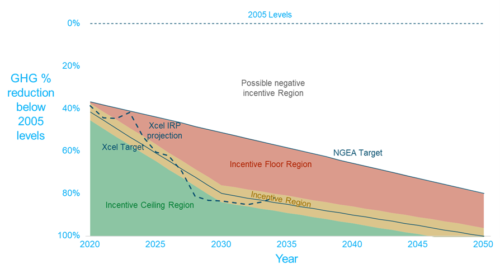
Xcel Energy’s announcement, late last year, of a 100% carbon-free goal by midcentury and an accompanying 80% GHG reduction goal by 2030 launched the company to the forefront of industry leadership and beyond state policy requirements. To accelerate its efforts, Xcel retained E3 to craft Performance Incentive Mechanisms (PIMs) to promote decarbonization in Minnesota.
PIMs provide utilities with a financial incentive to pursue a social or regulatory goal, such as decarbonization, where none exists. Adopting a PIM for generation portfolio emissions, for example, would both fill a gap in Minnesota’s decarbonization policy and provide an example other states could follow.
E3’s proposed PIMs focused on two key pillars of decarbonization: electricity generation and transportation electrification. The electricity generation PIM sets an incentive for GHG reductions beyond state targets in line with Xcel’s more aggressive goals. The transportation electrification PIMs reward beneficial behaviors by EV owners – enrolling in time-of-use rates and charging vehicles during off-peak times – rather than EV adoption rates, since utilities’ effect on adoption is unclear.
The PIMs were designed to be transparent, easily measurable, and adjustable in response to market transformation. They also reward incremental progress toward long-term goals while minimizing so-called “cliff effects,” whereby significant earnings changes result from small changes in performance.
The figure below illustrates Xcel’s electricity generation PIM. Setting an incentive floor avoids rewarding underperformance, while setting a ceiling caps the maximum total incentive. The figure also shows the differing trajectories of electric sector GHG emissions under Xcel’s integrated resource plan (IRP) and Minnesota’s Next Generation Energy Act (NGEA).

Working with Xcel’s regulatory team, E3 provided expert testimony proposing the PIMs in Xcel’s multiyear rate plan (MRP) filing in late 2019. These novel PIMs were recently named among the “Top Grid Modernization Trends of 2019.”
E3 expects to see similar filings in the coming years as regulators and utilities seek to better align incentives with decarbonization policy objectives.
Testimony


